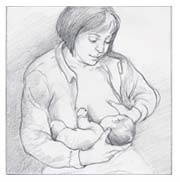Introducing first Solid Foods to your baby is a big milestone. But does your baby is ready for solid foods?
How do you Know if your Baby is ready for Solid Foods?
Your baby may be 3 months old or 4 months old when you start to feel she may need 'something more' than formula or breast milk. Maybe she is beginning to awaken more often at night or eat more often than 'usual' and you wonder if introducing solid foods may be what she needs.
Growth Spurt will occur between 3-4 months of age. Your baby may begin to wake more frequently at night for a feeding and may being to eat non-stop as she did as a newborn. Growth spurts often account for the increased hunger in you baby and should not taken as a sign that your baby needs solid foods added to her diet.
Signs that may Indicate Your baby is Ready for Solid Foods
Your baby may act interested in solid foods before he is developmentally ready to eat them. A baby's intestinal tract may not be fully developed before 6 months. Introducing solid foods before your baby's body is ready to handle them can cause constipation, gas and stomach pain. Starting solid foods too early can cause your baby to develop food allergies or sensitivities. It is normal for babies to go through a growth spurt between 4 and 6 months. If your infants act hungrier that before, it does not mean that he needs solid foods, but rather he needs to nurse frequently or drink more formula.
- Loss of tongue-thrust reflex : baby is able to drink and swallow liquids with ease
- Be able to let you know that she is full from a 'meal' with signs such as turning away from the bottle or breast. This is important so that baby is able to self-regulate the amount of food being eaten. This helps stop baby from accidentally overeating as parents may continue to feed baby thinking that she is still hungry.
- Have the ability to sit up and hold head up unassisted
- Interest in your food
- Has doubled his birth weight and weighs at least 13 pounds
- Frequently waking in the middle of the night when a solid sleeping pattern had been established.
An Alternative to Solid Foods.
If your baby has shown interest in solid food but is not quite developmentally ready, try giving him a breastmilk popsicle or momsicle, to give him a new food experience.


















